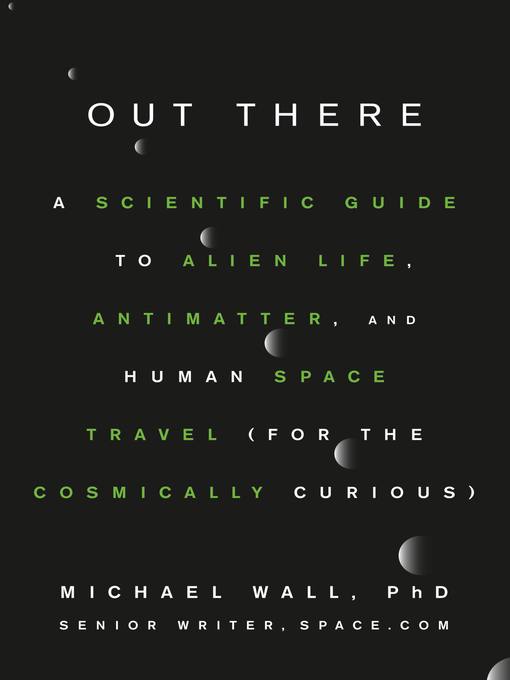
Out There
A Scientific Guide to Alien Life, Antimatter, and Human Space Travel (For the Cosmically Curious)
- اطلاعات
- نقد و بررسی
- دیدگاه کاربران
نقد و بررسی

August 20, 2018
With a humorous, accessible tone, Wall, a senior writer for Space.com, answers questions about alien life and space travel. He draws on the opinions of various experts—for instance, on the question of “Will Aliens Kill Us All?” he shares both the concerns of Stephen Hawking and the optimism of others like Doug Vakoch, president of METI (“messaging extraterrestrial intelligence”) International. Wall does remind readers that, as on Earth, extraterrestrial life will be “mostly microbes,” and returns several times to the subject of ALH 84001, the Martian rock that, in 1996, researchers reported had signs of life. After discussing these and other questions, such as “Could We Talk to ET?” (possibly not—the gulf between species might be too vast), Wall turns to human space travel. Elon Musk and Jeff Bezos get their obligatory mentions in the chapter on colonizing the Moon and Mars, while Mexican physicist Miguel Alcubierre and his theoretically possible warp drive leads off the chapter on interstellar travel. Readers of Michio Kaku’s The Future of Humanity will find some overlap, but this should appeal to anyone who has ever looked up into the sky and wondered what is out there. Agent: Matt Latimer, Javelin.

September 15, 2018
A conversational exploration of the possibility of life beyond Earth.Within a section on how the Earth may have been visited long ago by "voyaging aliens," perhaps even before humans had evolved, Wall writes, "let's indulge in some wild speculation, because it's fun!" Though his byline as a senior writer for Space.com includes his doctorate in biology, the speculation throughout his first book is more playful than scientifically rigorous, as befits a book with a bibliography that includes The Hitchhiker's Guide to the Galaxy, The Physics of Star Trek, and Alien Invasion: How to Defend Earth. Each chapter title poses a question: "Are We All Martians?"; "Do Aliens Have Sex?"; "Will Aliens Kill Us All?"; "Is Time Travel Possible?" In nearly every case, the answer is a qualified maybe. Instead of asking "why?" Wall asks, "why not?" Since the universe is so vast and there are so many possibilities of planets or moons or other bodies that might possibly sustain life, or once could have, isn't it more likely than not that life exists somewhere other than here? Again, one answer could stand for all: "We just don't have enough information at the moment to know what's actually going on." If there are aliens out there, they might be microbes or they might be more like machines. They might be hostile, in which case, "engaging an alien colony ship over Los Angeles or London, even with humanity's full complement of 15,000 nuclear weapons, would be comically fruitless, like fending off a charging rhino with a spatula." Or, perhaps, "advanced aliens may be silently monitoring us from afar like cosmic peeping toms, waiting for us to show that we want to talk."Somewhere between science fiction and science fact, there's a wide range of possibility concerning life in the great unknown.
COPYRIGHT(2018) Kirkus Reviews, ALL RIGHTS RESERVED.

November 1, 2018
The author's introduction accurately describes this book as "a little tour of the great beyond, asking some pertinent (and some impertinent) questions about ET." While Wall, a senior writer at space.com, holds a PhD in biology, this work is more a popular treatment of the possibility of life beyond our planet than a scientific guide, though it is based on scientific research. Early foundations of SETI research such as Enrico Fermi's famous "Where is Everybody?" question and Drake's equation for estimated alien civilizations are explained, as well as recent discoveries such as the exoplanets in the Trappist system and the organisms thriving in the vents of Earth's deepest ocean floors. The work's overview of new understandings of other sentient species is marred a bit by an abundance of pop culture references (e.g., to the Karadashians) that may soon become dated. Fortunately, the many quotes from scientists somewhat balances that. The provocative chapter titles (e.g., "Are We All Martians?") encourage readers to keep exploring. VERDICT This book provides a simple introduction to possibilities of other intelligent species in a conversational approach that should appeal to a wide range of readers.{amp}mdash;Sara R. Tompson, Jet Propulsion Laboratory Lib., Pasadena, CA
Copyright 2018 Library Journal, LLC Used with permission.

October 15, 2018
In this science-infused but accessible guide to extraterrestrials and space exploration, author Wall, a frequent contributor to Scientific American and NBC News, plays his own devil's advocate. First, he considers the research that has prompted evolving theories about the existence of alien life, what aliens look like, where they are, and how we'll get to them, and then he uses current science to debunk one possibility after another. Wall's witty and readable style is never preachy, and he readily acknowledges that new discoveries continue to turn long-held assumptions upside down (although it's probably safe to rule out moon-dwelling lunarians). This approach is effective in conveying lots of technical information within a context of manageable scenarios, bolstered by multiple pop-culture references. This style can prove validating, frustrating, or reassuring, in turn, depending on readers' viewpoints, but always manages to be engaging and encourages continuing speculation. Wall ends with a happy thought?Earth's impending doom?and his sincere hope that we'll be out among the stars by then.(Reprinted with permission of Booklist, copyright 2018, American Library Association.)




دیدگاه کاربران